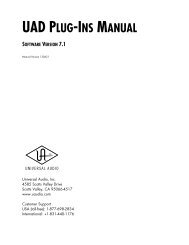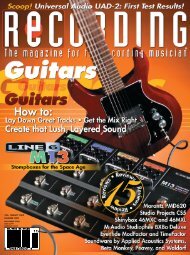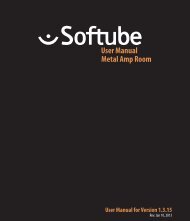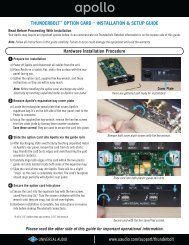Apollo 16 Hardware Manual.pdf - Universal Audio
Apollo 16 Hardware Manual.pdf - Universal Audio
Apollo 16 Hardware Manual.pdf - Universal Audio
You also want an ePaper? Increase the reach of your titles
YUMPU automatically turns print PDFs into web optimized ePapers that Google loves.
FireWire Basics<br />
FireWire (also known as “IEEE 1394” and “i.Link”) is a high-speed serial data interconnection protocol that is<br />
used to transfer digital data between devices. FireWire is commonly used to interconnect computer systems to<br />
hard drives, audio interfaces, and digital camcorders. A complete discussion of FireWire is beyond the scope of<br />
this manual, but some of the main points and how they apply to <strong>Apollo</strong> <strong>16</strong> are covered below.<br />
Important: On Windows systems, <strong>Apollo</strong> <strong>16</strong> requires a qualified PCIe-to-FireWire adapter card. For<br />
details, see www.uaudio.com/support/apollo<br />
FireWire vs. USB<br />
FireWire is considered superior to USB for audio purposes because it does not rely on the host processor to<br />
manage low-level data housekeeping (among other reasons). FireWire typically outperforms USB at the same<br />
rated speeds.<br />
FireWire Bus<br />
FireWire devices are connected to a FireWire “bus” which is comprised of all devices in the serial data stream.<br />
The FireWire specification supports up to 63 devices per FireWire bus.<br />
Many FireWire devices and host computers have more than one FireWire connector, but these connectors almost<br />
always attach to the same FireWire bus (most computers do not have more than one FireWire bus). It is possible<br />
to add another FireWire bus to a computer, typically by adding a PCIe-to-FireWire or ExpressCard-to-FireWire<br />
adapter card.<br />
Bus Power<br />
Some FireWire devices can be “bus powered” which means the device derives its operating electricity from the<br />
FireWire bus itself without a power supply of its own. <strong>Apollo</strong> <strong>16</strong> cannot be bus powered and it does not supply<br />
bus power from its FireWire ports to other devices.<br />
Powering Down<br />
Powering down or disconnecting <strong>Apollo</strong> <strong>16</strong> when UAD plug-ins are loaded could cause session data loss and/<br />
or unpredictable behavior. Quit all UAD host applications (DAW, Console, UAD Meter & Control Panel) before<br />
disconnecting <strong>Apollo</strong>.<br />
FireWire 800 vs. FireWire 400<br />
The most common FireWire devices are available in two speeds: FireWire 400 (IEEE 1394a), which supports<br />
transfer speeds up to 400 megabits per second, and FireWire 800 (IEEE 1394b), which supports up to 800<br />
megabits per second. It’s usually possible to determine the speed of the FireWire device by the type of FireWire<br />
connector it uses. <strong>Apollo</strong> <strong>16</strong> is a FireWire 800 device.<br />
<strong>Apollo</strong> <strong>16</strong> <strong>Hardware</strong> <strong>Manual</strong><br />
23<br />
FireWire Basics
















